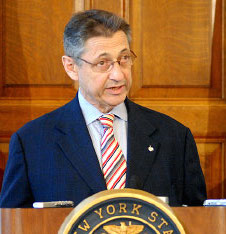
In the long and storied political history of New York State, few things were ever as inevitable as Eliot Spitzer’s election to the governor’s office. As state attorney general, he already loomed as governor-presumptive before the Republican incumbent, Gov. George Pataki, confirmed in the summer of 2005 that he would not seek a fourth term. By November 2006, Mr. Spitzer’s landslide (69%) victory over an articulate but underfunded Republican opponent was a foregone conclusion.
There were warning signs about his dark side. But to many New Yorkers, prosecutorial nastiness seemed to be just what was needed to reform the decadent political culture of Albany—a place seldom mentioned in print without the modifier “dysfunctional.”
Indeed, given his record, the millions who cast their ballots for him had reason to expect that Hurricane Eliot would tear up, root and branch, all that was wrong in the capital. What they got instead was more like a parking lot whirlwind—stirring up the trash and pushing around shopping carts, but leaving no fundamental change in its wake.
Within days of taking office, Mr. Spitzer seemed to be feuding with everyone in sight. Personality issues aside, his “reform” agenda was muddled at best. On fiscal issues, jaws dropped even in Democratic circles when the new governor listed “spending control” among the hallmarks of his first budget—which ended up boosting spending by 7%. Mr. Spitzer pledged himself to a record multiyear increase in aid to the state’s public schools, already the best-financed in the country. He proposed well over $2 billion in tax and fee hikes, while denying that he had called for anything other than “loophole-closers.” His much-publicized fight over Medicaid “cuts” boiled down to a dispute over marginal changes. And he added thousands of positions to the state payroll.
New York’s fiscal year begins unusually early, on April 1, so this year’s budget negotiations with the state legislature were about to enter a crucial period when news of Client 9 broke on Monday afternoon. And now the Spitzer storm has blown out to sea.
He leaves behind a state whose troubles are best summarized by a single population statistic: Since 2000, more than a million New Yorkers have moved to other states, the biggest outmigration loss in the nation. The Empire State’s net population has been propped up only by foreign immigrants, most of whom settle in New York City. Various economic indexes consistently rank New York’s business and tax climate among the worst in the nation.
To a great degree, New York owes its sclerotic government and slow economic growth to its status as the nation’s most heavily unionized state. Roughly half of those union members work in the public sector, and a growing number of the rest are employed in the heavily government-subsidized health-care industry. Organized labor’s clout in Albany has never been stronger—and in various ways, Mr. Spitzer was feeding it.
The power of the unions—combined with well organized lobbying by hospitals and nursing homes—also explains why New York continues to maintain the nation’s most expensive Medicaid program, spending nearly twice the per-recipient average for all states.
The burden of the bloated public sector weighs most heavily on the upstate region. High taxes, plus high business costs for energy and small group insurance, make it difficult to revive communities beaten down by the decline of manufacturing employment. The Bush tax cuts helped New York City and its surrounding suburbs to recover strongly, if belatedly, from recession and terrorist attacks earlier in the decade. But Wall Street—the heart of New York’s economy and the state’s revenue base—is now reeling from the credit market crisis.
The responsibility for dealing with these problems now falls to Lt. Gov. David Paterson, who will be sworn in as governor in just days. Prior to joining Mr. Spitzer’s ticket, during a 21-year career in the state Senate’s Democratic minority, Mr. Paterson became best known for two things: He is legally blind, and he is the probably the wittiest, most agreeable politician in the state Capitol.
Mr. Paterson, who will be the state’s first African-American governor, got his start as the protege of a circle of older, Harlem-based politicians including his father, former state senator and secretary of state Basil Paterson; U.S. Rep. Charles Rangel; and David Dinkins, who was city clerk and Manhattan borough president before his disastrous single term as mayor.
During the 1990s, Mr. Paterson dutifully voted for Republican-sponsored state tax cuts because they were included in bipartisan budget deals. But as Senate minority leader in 2005 and 2006, he was the prime sponsor of a bill that would have increased New York City’s top income tax rate by 22%, to fund a school class-size reduction initiative. He co-sponsored a proposed $2.7 billion state income tax increase to pay for even higher school spending, and a big personal tax exemption for public school teachers. Neither bill went anywhere—but both may provide a telling glimpse into Mr. Paterson’s thinking.
Then again, while Mr. Paterson has close ties to labor unions as well as Democratic Party warhorses like Rep. Rangel, he also has supported an expansion of charter schools, and has shown an affinity for a newer generation of change-oriented urban politicians like Newark, N.J.’s Mayor Corey Booker, to whose campaign he steered a $10,000 contribution in 2006.
Mr. Paterson takes office in difficult circumstances well liked, and with a large store of goodwill. After all the hope and hype surrounding Mr. Spitzer upon his arrival, expectations have descended from the stratosphere. At this point, New Yorkers would settle for competence.






